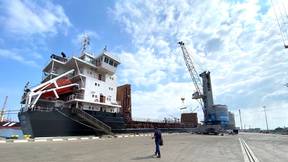SS&Y Capesize Indices
SS&Y Pacific And Atlantic Capesize Indices Drop Shipbrokers Simpson, Spence and Young's Pacific Capesize Index fell 45 points to 5,284 in the week ending March 27. "The Pacific sector remains tight, with owners gaining firm rates in a positional market," SS&Y said. "Tonnage is scarce for early positions, allowing owners to play a stronger hand," SS&Y added. SS&Y's Atlantic Capesize Index fell 85 points to 5,179 in the same week. "The fall in this week's index was due to rates obtainable for Richards Bay/Rotterdam and Bolivar/Rotterdam, down to around $10 and the mid $7 respectively," SS&Y said. "However, there is a firm belief that the market will remain strong, with South Korea in particular still an area of heavy demand for capers from the Atlantic," SS&Y added.
SS&Y Capesize Indices
Shipbrokers Simpson, Spence and Young's Pacific Capesize Index fell 243 points to 5,259 in the week ending May 8. "The Pacific Capesize index fell after the holidays in the Far East, with early vessels becoming the victims of a lack of inquiry," SS&Y said. "A $1 fall on the Queensland/Rotterdam route (120/150,000 ton cargo) was certainly not going to help the index, which witnessed its first serious decline since January," SS&Y added. Shipbrokers Simpson, Spence and Young's Atlantic Capesize Index fell 131 points to 4,786 in the week ending May 8. "The Atlantic Capesize index dived on the back of weaker demand, which softened rates for early tonnage. However, iron ore demand in the Atlantic remained steady and limited the fall in rates to more moderate levels," SS&Y said.
SS&Y Capesize Indices Both Rise
Shipbrokers Simpson, Spence and Young's Pacific Capesize Index rose 76 points in the week ending Monday to 5,060. "The index rose back above the psychological 5,000 barrier despite a relatively quiet week," SS&Y said. "Japanese steel production was down on last month's highs but still remains a force to be reckoned with and South Africa is drawing tonnage away from the Pacific, giving further cause for optimism amongst owners." Meanwhile, its Atlantic Capesize Index rose 18 points in the week ending Monday to 5,162. "Few new cargo stems came to the market over the last week but one cannot discount the steady tone of the rates despite this," SS&Y said.
Capesize Rates Take a Huge Dive
Freight rates for Capesize ships have been hammered this week, falling by the biggest margin seen in over four years, brokers said. London shipbroker SSY said this represented “the largest single week fall,” since it launched its Capesize indices in January 1997. The fall was caused, said SSY, by the fact that few bookings had emerged for ships to carry iron ore cargoes to Japanese steel mills at the end of March and start of April. This followed a spike in activity over the last few weeks as steel mills rushed to book ships for cargoes bought before higher commodity prices take effect on April 1. On the benchmark Atlantic basin ore route from Tubarao to Japan, freight fell by $1.1 per ton during the week to reach $9.1 per ton on Monday.
SS&Y Capesize Indices Rise
Shipbrokers Simpson, Spence and Young's Atlantic Capesize Index rose 53 points to 4,420 in the week ending Nov. 29. "Increasing pressure on fronthaul rates, particularly for modern tonnage, has brought a firm tone to routes to the Far East, and demand for end December in to the start of 2000 will keep owners optimistic that rates will climb further," SS&Y reported. SS&Y's Pacific Capesize Index rose 173 points to 4,455 in the same week. "The Pacific Capesize Index has risen to its highest level since its inception in January 1997 as Chinese inquiry, which has been the prime mover of the recent firmer tone, remained a key feature," SS&Y reported. "It seems quite possible that the firm tone will continue in to the New Year as demand remains healthy," SS&Y added.
SS&Y Capesize Indices Fall
Shipbrokers Simpson, Spence and Young's Pacific Capesize Index fell 152 points to 4,194 in the week ending Nov. 1. "The index fell as only Chinese cargoes remained very active, with brokers indicating that trans-Pacific rates for west Australia/China had held up to the softening trend," SS&Y reported. SS&Y 's Atlantic Capesize Index fell 242 points to 4,218. "A lack of early cargo and the standard 161,000 dwt Hyundai vessel fixing in the high teens rather that the low twenties last week led to rates softening in the charterers favor," SS&Y reported. "Richards Bay activity was very slow, with implied rates from there to Rotterdam slipping to the mid $7 from nearer $8 per ton a week ago," SS&Y added. Volatility was still high, reflecting the finely balanced supply and demand situation.
SS&Y Capesize Indices Fall
Shipbrokers Simpson, Spence and Young's Pacific Capesize Index fell 32 points to 4,346 in the week ending Oct. 25. "Despite a 32 point decline in the index, there seems to be continued buoyancy for cargoes into Japan and China for November positions, and Hyundai 161,000 dwt Capesizes broker $20,000 daily for trips into the Far East," an SS&Y spokesperson said. "Some vessels were fixed and failed as rates generally eased back over last week, and with sufficient tonnage to satisfy demand in the Pacific, rates could face a possible softening this week," he added. SS&Y's Atlantic Capesize Index also dropped last week, falling 60 points to 4,460.
SS&Y Capesize Indices Mixed
Shipbrokers Simpson, Spence and Young's Pacific Capesize Index fell 27 points to 4,428 in the week ending Dec. 6. "A flat week led to a dip of 27 points as the Queensland/Rotterdam route fell 40 cents while routes to Beilun strengthened," SS&Y reported. "Forecast for seaborne trade in steam and coking coal and iron ore look bullish for 2000. A slow first quarter will be turned around by the second quarter for an optimistic 2000 for owners," SS&Y added. SS&Y's Atlantic Capesize Index rose five points to 4,425 last week. "The index had a flat week rising just five points but average earnings for a standard Capesize vessel (161,000 dwt) across the four BCI routes, have risen by 65.7 percent to $16,204 daily from their second quarter low," SS&Y reported.
SS&Y Capesize Indices Mixed
Shipbrokers Simpson, Spence and Young's Pacific Capesize Index fell 16 points to 4,444 in the week ending Dec. 13. "Rates in the Pacific have remained on or around previous levels despite increased tonnage availability and light fixing in the region," SS&Y reported. SS&Y's Atlantic Capesize Index rose 146 points to 4,571 in the same week. "Despite limited activity, tight Atlantic tonnage lifted trans-Atlantic rates accordingly," SS&Y reported.
SS&Y Capesize Indices Fall
Shipbrokers Simpson, Spence and Young's Pacific Capesize Index fell 125 points to 4,293 in the week ending Dec. 29. "The final Pacific Capesize Index of 1999 brought a slight tinge of disappointment for owners," SS&Y reported. SS&Y's Atlantic Capesize Index fell 87 points to 4,532 in the same week. "The 87 point drop in the index won't have been unexpected due to the seasonal effect of holidays on demand," SS&Y reported.
SS&Y's Capesize Indices Drop
Shipbrokers Simpson, Spence and Young's Pacific Capesize Index fell 45 points to 4,060 in the week ending Jan. 24. "A fresh decline in the Pacific Capesize Index this week indicated that the market has turned in the charterers' favor. Although we feel that this is only a temporary change in direction," SS&Y reported. "The demand forecasts from Asia and Japan in particular remain bullish towards the back end of the first quarter," SS&Y added. SS&Y's Atlantic Capesize Index fell 71 points to 4,248 in the same week. "The Atlantic Capesize index lost another 71 points this week and has dropped 213 points since the start of the year, but we feel that this is line with our predictions of some months ago…
Capesize Indices Rise
Shipbrokers Simpson, Spence and Young's Pacific Capesize Index rose 626 points in the week ending Monday, Feb. 14, to 4,449. "Charterers who had been watching the weakening market over the first weeks of 2000, chose the Chinese New Year to enter the market with new requirements," SS&Y said. SS&Y’s Atlantic Capesize Index rose 495 points in the week ending Monday, Feb. 14, to 4,500. "Increased demand due to end of fiscal year stockpiling/completion of 1999 contracts resulted in available tonnage being quickly drained and a rapid rise in the freight market," SS&Y said.








